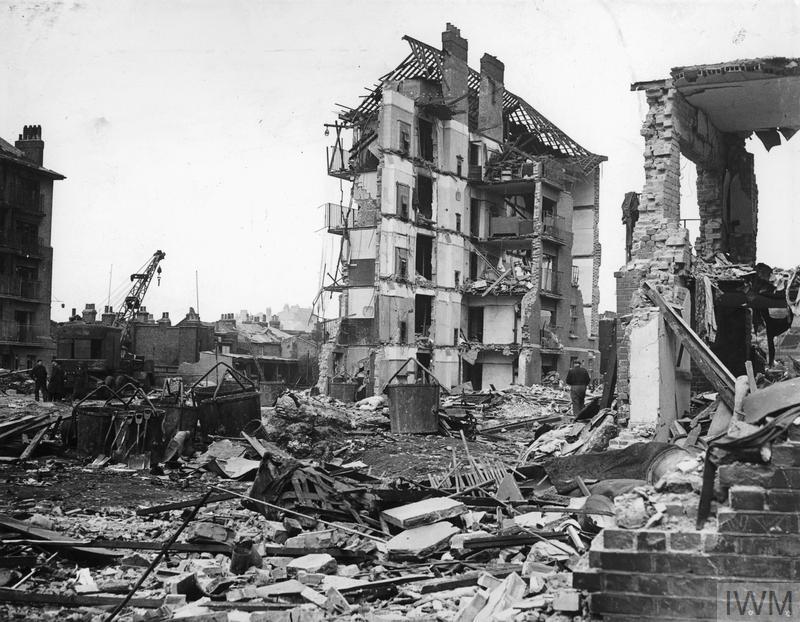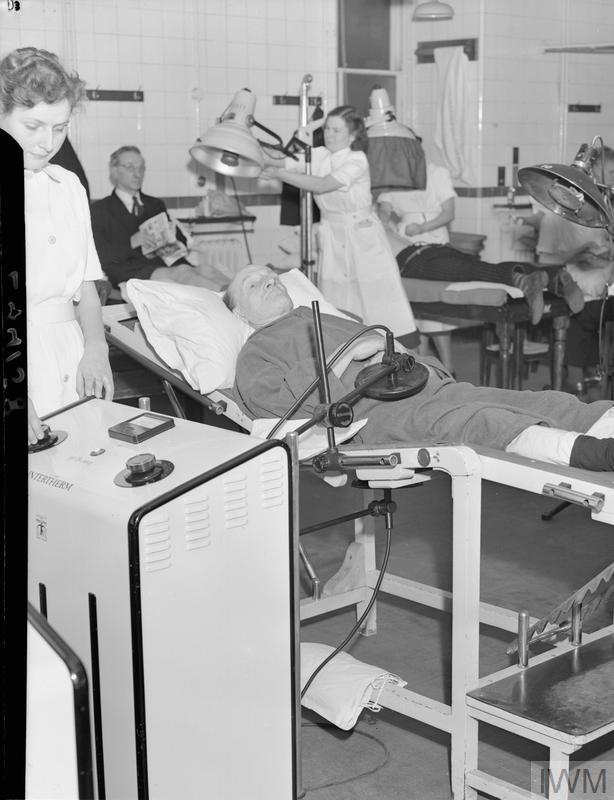
On 20 March 1956, commuters passing Old Street station in London heard a strange and unfamiliar sound, piercing through the din of the surrounding cars and buses. It was a cry for help.
Tracing the noise to a nearby bomb site, concerned passers-by discovered a fifty-something year-old man – a “vagrant” who was “unkempt and bearded” – lying amidst the rubble. After informing these onlookers that he was unable to stand up or support his own weight, the man was rushed one mile down the road to St Bartholomew’s Hospital for medical assistance.
On admission, doctors learned that the man had been on the road for almost twenty years and, with the exception of a few years of military service during the Second World War, had been surviving on intermittent, casual employment. However, finding himself out of work since the previous December, the man had resigned himself to “a precarious existence” on the streets of London, eventually setting up his “headquarters” on the abandoned lot in Old Street. By the time he had arrived at the bomb site, he had not taken his shoes or socks off for ten weeks and his feet had become swollen and painful. After a fortnight sleeping outside in below freezing temperatures, he soon found himself too weak to move.
On closer examination, doctors concluded that the man was suffering from a condition that had been considered a relic of the past – ‘trench foot’. His feet and lower legs were swollen, cold to the touch, and turning a concerning shade of pale blue, and he reported feeling no sensation at all below his ankles. The man was immediately put to bed with his feet exposed to the room temperature air and placed on a course of fresh blood and penicillin.
After a week on the ward, the man’s swelling was starting to subside; however, as it did, his toes began turning black and painful blisters formed on the soles of his feet. After five weeks, gangrene began to take hold. After twelve weeks, despite intensive treatment efforts, doctors admitted defeat. As a last resort, the man was dispatched to the operating theatre where surgeons amputated both of his legs below the knee.

When this case was published in the British Medical Journal two years later, the authors remarked on the surprisingly anachronistic nature of the man’s clinical journey, from his initial injury to his final therapeutic outcome.
Firstly, the authors noted that the condition of the man’s feet called to mind injuries that had long been considered an exclusive product of wartime experience, at once resembling the ‘trench foot’ of soldiers on the Western Front, the ‘immersion foot’ of sailors shipwrecked for extended periods during the Battle of the Atlantic, and the ‘shelter foot’ of civilians forced to hide in cold, damp air-raid shelters during the Blitz. This was certainly not the kind of injury doctors were expecting to see during a period of peace and relative prosperity.
Secondly, the continued deterioration of the man’s injury seemed out of touch with the optimism of modern therapeutic regimes. Despite weeks of slow, measured, and non-invasive therapy informed by the most recent principles of management – immobilizing the leg, exposing the feet to room temperature, carefully monitoring the patient’s food and fluid intake, using antibiotics to treat the gangrene, tracking the circulation of blood using UV light – the man’s doctors were unable to prevent the rapid spread of infection.
Finally, the decision to perform a bilateral amputation underscored this sense of medical and surgical failure. Prior to the First World War, amputations had been increasingly seen as an uncomfortable reminder of surgery’s ‘brutal’ and ‘primitive’ past. As surgeon J.P. Lockhart Mummery observed, “modern surgical methods of asepsis had rendered surgeons more and more conservative with regard to diseases and injuries of the limbs, so that the necessity for amputations seldom arose.” While the industrialized brutality of the war to come necessarily brought amputation back to the fore of surgical practice, the procedure nonetheless retained much of this stigma in professional circles, particularly in relation to comparatively minor injuries such as trench foot. As Aubrey Scott Gillett of the Royal Army Medical Corps argued in 1916, amputation could almost always be avoided in such cases if experienced surgeons practiced patient observation and restrained “trimming” of the affected areas. “If more stress were laid on this,” Gillett proposed, “there would not be half the number of men with amputated limbs and toes.”
As such, both the patient’s injury and the failure of therapeutic interventions seemed to expose the limits of medical and surgical modernity and, in turn, the modernity of the post-war nation as expressed and invested in the establishment of a National Health Service that could conquer disease and curb mortality.[1] Instead, the sight of the man’s blackened feet served as a stark reminder to doctors and surgeons alike that new hospitals, new medicines, and new surgical techniques could not alone eradicate poverty and human suffering.

Sixty years later, this disjuncture between our perceptions of medical and surgical progress and the realities of poverty and homelessness continue unabated. People experiencing homelessness constitute one of the most vulnerable groups in society with regards to health and illness, with higher rates of infectious disease, greater complications from drug and alcohol use, increased exposure to both accidental injury and violent assault, and significantly lower life expectancy - with the mean age of death for homeless men and women being just 45 and 43 years old respectively – than the general population. Yet, despite these complex needs, individuals who are homeless tend to have significantly poorer access to and worse encounters with healthcare services, with comparatively low rates of GP registration, an over-reliance on emergency care, and less successful therapeutic outcomes than their housed peers.
Perhaps nowhere is this dangerous combination of elevated need and impoverished access seen more clearly than when considering the complex surgical needs of those sleeping rough or in otherwise precarious forms of accommodation. Despite experiencing high rates of physical trauma – including traumatic brain injuries, burns, frostbite, skin and soft tissue injuries, and complex fractures – studies have shown that individuals experiencing homelessness will often delay seeking medical and surgical assistance for days, weeks, months, or even years. This delay is motivated by a number of factors, including competing subsistence needs, lack of transportation, and various bureaucratic obstructions. However, perhaps the most important factor of all is the expectation of discrimination and stigma in healthcare settings, often solidified by previous negative experiences with nurses, doctors, surgeons, receptionists, and security staff. Thus, for many people who experience homelessness, hospitals and operating theatres are perceived as sites of pain, mistrust, and humiliation, rather than refuges of care, treatment, and recovery.
Access, however, is not the only issue. For those who are able to receive medical and surgical treatment, the recovery and healing process presents its own unique challenges. Firstly, while an operation might rectify the immediate injury at hand, the underlying problems these patients experience often go unaddressed. As Alex Bax, Chief Executive of homeless healthcare charity Pathway, has observed: “A man might be in hospital for a broken leg but the fact that he has uncontrolled diabetes, has trenchfoot, and is an alcoholic is not seen as the orthopaedic surgeon’s problem.” Secondly, such patients can often find themselves discharged back onto the street or into precarious housing, neither of which is conducive to post-operative recovery. Unsurprisingly, studies suggest that homeless patients are therefore more likely to experience post-discharge wound complications and unplanned readmissions to hospital.
Once again, the modernity of medical therapies and surgical techniques finds itself at odds with the harsh realities of poverty. As Manchester GP Gerry O’Shea astutely notes: “Homeless patients come into hospital and get this hi-tech medicine but are then sent back on the streets where there’s nothing for them.”

These complex problems clearly do not have a single, easy fix. However, those working in the field of inclusion health frequently emphasize two key areas for improvement. Firstly, nurses, doctors, and surgeons must understand that the reluctance of homeless patients to utilize healthcare services, attend follow-up appointments, and adhere to strict regimens for treatment and post-operative recovery does not stem from an irrational rejection of medical and surgical expertise; rather, when weighed against previous negative experiences and competing needs for survival, choosing to avoid the hospital or the operating theatre can appear as an act of self-preservation. Healthcare services for homeless individuals must be designed with sufficient flexibility and reflexivity to respond to these experiences and meet these needs if they are to be fit for purpose.
Secondly, inclusion health specialists frequently emphasise that one vital solution to the significant problems facing homeless patients is not ‘hi-tech’ medical and surgical innovations, but rather something altogether more fundamental: housing. This argument is central to the work of organisations and initiatives such as Pathway, Housing First England, and Time to Heal, who recognize that stable accommodation – without the attachment of restrictive and unrealistic eligibility requirements – must be prioritized before other medical, psychological, and social needs can be met. Without such efforts, the tragic costs of poverty and homelessness will continue to outweigh even the most pioneering of innovations in modern medicine and surgery.
[1] On the NHS and post-war modernity, see Roberta Bivins, Contagious Communities: Medicine, Migration, and the NHS in Post-War Britain (Oxford: Oxford University Press, 2015).